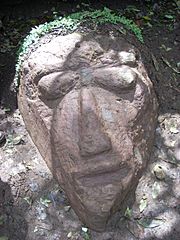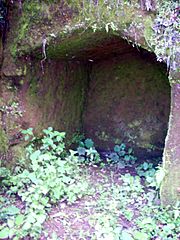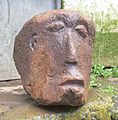Chojolom facts for kids
Chojolom is a small, ancient Maya site located high in the mountains of western Guatemala. This special place has many carved stones. Experts believe these stones were made by the Kʼicheʼ Maya people during the Postclassic Period, which was from about 900 to 1520 AD.
Chojolom sits on a hill in a town called Cantel. This town is in the Quetzaltenango region of Guatemala. Today, most people living in Cantel are still Kʼicheʼ Maya. Cantel is about 10 kilometers (6 miles) from the city of Quetzaltenango. People think Chojolom was a place where ancient Maya rituals and ceremonies happened.
The name Chojolom comes from the Kʼicheʼ Maya language. It means "by the head." The word jolom means "head." A local historian, Mariano Cornejo, thinks that the name of the hill and the stone heads found there might be connected.
Contents
Discovering Ancient Sculptures
As of 2010, three amazing stone heads have been found at Chojolom. One looks like an armadillo, one is a human head, and the third is a deity (a god or goddess). These heads were found after heavy rain washed away mud in 2010. One of the stone heads was even discovered inside a cave at the site!
Archaeologists also found ancient pottery and bones. These items might have been part of special offerings or rituals. Besides the stone heads, a clay head was also found. In October 2010, a small landslide uncovered a stone altar hidden under a tree root.
The Armadillo Head
The Armadillo Head is about 15 by 20 centimeters (6 by 8 inches) in size. The nine-banded armadillo is an animal that lives naturally in the Cantel area. This armadillo head was the first of the three stone heads found by a local farmer named Sebastián Sam.
The Human Head
The Human Head sculpture is about 50 by 50 centimeters (20 by 20 inches). It was the second stone head discovered at the Chojolom site.
The Deity Head
The Deity Head is the biggest sculpture found so far. It measures about 1.1 by 1.4 meters (3.6 by 4.6 feet). This was the third stone head found at Chojolom.
The Altar
The Altar is a stone slab about 25 by 50 centimeters (10 by 20 inches). It has carvings that show circles, hills, human figures, and a deer. A Guatemalan expert, Lina Barrios, believes the six human figures combined with the deer might represent a specific Maya calendar date.
Gallery
See also
 In Spanish: Chojolom para niños
In Spanish: Chojolom para niños





